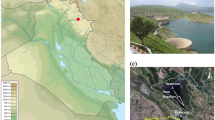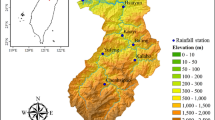Abstract
Predicting reservoir outflow is crucial for managing water resources in under extreme flood and drought conditions. Time series study of reservoir outflow relies heavily on previous information on climate and reservoir factors. The Long Short Term Memory model of Deep Learning is applied using rainfall, rainfall intensity, runoff rate, temperature, surface water area, and reservoir outflow to predict reservoir outflow. This study summarizes the parameter setting effect on model performance and analyzes the main factors that affect reservoir outflow prediction. Monthly rainfall, rainfall intensity, runoff rate, temperature, outflow, and surface water area data are used in the multipurpose reservoir prediction model to analyze monthly and yearly water outflow of the reservoir. This system help in water management to reduce the risk of flooding downstream while ensuring sufficient water storage for monthly utilization, i.e., an outflow of a reservoir to the city. This method determines the appropriate amount of water released from the reservoir during the dry season and helps set a relationship with other input variables and outflow. The model has been trained and tested using the obtained data. The result analyzes that combined iterations and neurons of a hidden layer mainly impact manipulating the model precision; computation speed is primarily affected by the batch size of the model. The proposed model can simultaneously predict entire parameters in an accurate and efficient way.

(Source: Survey of India)
















Similar content being viewed by others
Data availability statement
Some or all data, models, or code generated or used during the study are proprietary or confidential and may only be provided with restrictions.
Abbreviations
- ANN:
-
Artificial neural network
- RNN:
-
Recurrent neural network
- MLP:
-
Multilayer perceptron
- LSTM:
-
Long short term memory
- BPTT:
-
Back propagation through time
- GRU:
-
Gated recurrent unit
References
Al-Shabandar R, Jaddoa A, Liatsis P, Hussain AJ (2020) A deep gated recurrent neural network for petroleum production forecasting. Mach Learn Appl. https://doi.org/10.1016/j.mlwa.2020.100013
Chaki S, Zagayevskiy Y, Shi X, Wong T, Noor Z (2020) Machine learning for proxy modeling of dynamic reservoir systems: deep neural network dnn and recurrent neural network RNN applications. Int Pet Technol Conf. https://doi.org/10.2523/IPTC-20118-MS
Chaves P, Tsukatani T, Kojiri T (2004) Operation of storage reservoir for water quality by using optimization and artificial intelligence techniques. Math Comput Simul 67:419–432
Cheng M, Fang F, Kinouchi T, Navon IM, Pain CC (2020) Long lead-time daily and monthly streamflow forecasting using machine learning methods. J Hydrol 590:125376. https://doi.org/10.1016/j.jhydrol.2020.125376
Ding Y, Li Z, Zhang C, Ma J (2020) Prediction of ambient PM2. 5 concentrations using a correlation filtered spatial-temporal long short-term memory model. Appl Sci 10(1):14
Elman JL (1990) Finding structure in time. Cogn Sci 14(2):179–211. https://doi.org/10.1207/s15516709cog1402_1
Fang Z, Wang Y, Peng L, Hong H (2020) Predicting flood susceptibility using long short-term memory (LSTM) neural network model. J Hydrol. https://doi.org/10.1016/j.jhydrol.2020.125734
Gangrade S, Lu D, Kao SC, Painter SL (2022) Machine learning assisted reservoir operation model for long-term water management simulation. JAWRA J Am Water Resour Assoc. https://doi.org/10.1111/1752-1688.13060
García-Feal O, González-Cao J, Fernández-Nóvoa D, Astray Dopazo G, Gómez-Gesteira M (2022) Comparison of machine learning techniques for reservoir outflow forecasting. Nat Hazard 22(12):3859–3874. https://doi.org/10.5194/nhess-22-3859-2022
Greff K, Srivastava RK, Koutník J, Steunebrink BR, Schmidhuber J (2017) LSTM: a search space odyssey. IEEE Trans Neural Networks Learn Syst 28(10):2222–2232. https://doi.org/10.1109/TNNLS.2016.2582924
He S, Gu L, Tian J, Deng L, Yin J, Liao Z, Hui Y (2021) Machine learning improvement of streamflow simulation by utilizing remote sensing data and potential application in guiding reservoir operation. Sustainability 13(7):3645. https://doi.org/10.3390/su13073645
Herbert ZC, Asghar Z, Oroza CA (2021) Long-term reservoir inflow forecasts: enhanced water supply and inflow volume accuracy using deep learning. J Hydrol 601:126676. https://doi.org/10.1016/j.jhydrol.2021.126676
Hongliang WANG, Longxin MU, Fugeng SHI, Hongen DOU (2020) Production prediction at ultra-high water cut stage via recurrent neural network. Pet Explor Dev 47(5):1084–1090. https://doi.org/10.1016/S1876-3804(20)60119-7
Huang I, Chang MJ, Lin GF (2022) An optimal integration of multiple machine learning techniques to real-time reservoir inflow forecasting. Stoch Env Res Risk Assess 36(6):1541–1561. https://doi.org/10.1007/s00477-021-02085-y
Idrees MB, Jehanzaib M, Kim D et al (2021) Comprehensive evaluation of machine learning models for suspended sediment load inflow prediction in a reservoir. Stoch Environ Res Risk Assess 35:1805–1823. https://doi.org/10.1007/s00477-021-01982-6
Jiang D, Xu Y, Lu Y, Gao J, Wang K (2022) Forecasting water temperature in cascade reservoir operation-influenced river with machine learning models. Water 14(14):2146. https://doi.org/10.3390/w14142146
Kao IF, Zhou Y, Chang LC, Chang FJ (2020) Exploring a long short-term memory based encoder-decoder framework for multi-step-ahead flood forecasting. J Hydrol. https://doi.org/10.1016/j.jhydrol.2020.124631
Kratzert F, Klotz D, Brenner C, Schulz K, Herrnegger M (2018) Rainfall-runoff modelling using long-short-term-memory (LSTM) networks. Hydrol Earth Syst Sci 22(11):6006–6022. https://doi.org/10.5194/hess-22-6005-2018
Latif SD, Birima AH, Ahmed AN, Hatem DM, Al-Ansari N, Fai CM, El-Shafie A (2022) Development of prediction model for phosphate in reservoir water system based machine learning algorithms. Ain Shams Eng J 13(1):101523. https://doi.org/10.1016/j.asej.2021.06.009
Lv N, Liang X, Chen C, Zhou Y, Li J, Wei H, Wang H (2020) A long short-term memory cyclic model with mutual information for hydrology forecasting: a case study in the Xixian basin. Adv Water Resour. https://doi.org/10.1016/j.advwatres.2020.103622
Matheussen BV, Granmo OC, Sharma J (2019) Hydropower optimization using deep learning. International conference on industrial, engineering and other applications of applied intelligent systems. Springer, Cham, pp 110–122. https://doi.org/10.1007/978-3-030-22999-3_11
Navale V, Mhaske S (2022) Artificial neural network (ANN) and adaptive neuro-fuzzy inference system (ANFIS) model for Forecasting groundwater level in the Pravara River Basin, India. Model Earth Syst Environ. https://doi.org/10.1007/s40808-022-01639-5
Ni L, Wang D, Singh VP, Wu J, Wang Y, Tao Y, Zhang J (2020) Streamflow and rainfall forecasting by two long short-term memory-based models. J Hydrol 583:124296. https://doi.org/10.1016/j.jhydrol.2019.124296
Paul T, Raghavendra S, Ueno K, Ni F, Shin H, Nishino K, Shingaki R (2021) Forecasting of reservoir inflow by the combination of deep learning and conventional machine learning. 2021 international conference on data mining workshops (ICDMW). IEEE, pp 558–565. https://doi.org/10.1109/ICDMW53433.2021.00074
Qiu R, Wang Y, Rhoads B, Wang D, Qiu W, Tao Y, Wu J (2021) River water temperature forecasting using a deep learning method. J Hydrol 595:126016. https://doi.org/10.1016/j.jhydrol.2021.126016
Ren T, Liu X, Niu J, Lei X, Zhang Z (2020) Real-time water level prediction of cascaded channels based on multilayer perception and recurrent neural network. J Hydrol. https://doi.org/10.1016/j.jhydrol.2020.124783
Sharifi MR, Akbarifard S, Qaderi K et al (2021) Comparative analysis of some evolutionary-based models in optimization of dam reservoirs operation. Sci Rep 11:15611. https://doi.org/10.1038/s41598-021-95159-4
Shen C, Lawson K (2021) Applications of deep learning in hydrology. Deep Learn Earth Sci Compr Approach Remote Sens Clim Sci Geosci. https://doi.org/10.1002/9781119646181.ch19
Shi X et al (2015) Convolutional LSTM network: a machine learning approach for precipitation nowcasting. Adv Neural Inf Process Syst 28:802–810
Song X, Liu Y, Xue L, Wang J, Zhang J, Wang J, Cheng Z (2020) Time-series well performance prediction based on long short-term memory (LSTM) neural network model. J Pet Sci Eng 186:106682. https://doi.org/10.1016/j.petrol.2019.106682
Sun AY (2020) Optimal carbon storage reservoir management through deep reinforcement learning. Appl Energy 278:115660. https://doi.org/10.1016/j.apenergy.2020.115660
Tut Haklidir FS, Haklidir M (2020) Prediction of reservoir temperatures using hydrogeochemical data, Western Anatolia geothermal systems (Turkey): a machine learning approach. Nat Resour Res 29(4):2333–2346. https://doi.org/10.1007/s11053-019-09596-0
Wang L, Xu B, Zhang C, Fu G, Chen X, Zheng Y, Zhang J (2022) Surface water temperature prediction in large-deep reservoirs using a long short-term memory model. Ecol Indic 134:108491. https://doi.org/10.1016/j.ecolind.2021.108491
Xu W, Meng F, Guo W, Li X, Fu G (2021) Deep reinforcement learning for optimal hydropower reservoir operation. J Water Resour Plan Manag. https://doi.org/10.1061/(ASCE)WR.1943-5452.0001409
Yang T, Gao X, Sorooshian S, Li X (2016) Simulating California reservoir operation using the classification and regression-tree algorithm combined with a shuffled cross-validation scheme. Water Resour Res 2016(52):1626–1651
Yang Y, Dong J, Sun X, Lima E, Mu Q, Wang X (2017) A CFCC-LSTM model for sea surface temperature prediction. IEEE Geosci Remote Sens Lett 15(2):207–211. https://doi.org/10.1109/LGRS.2017.2780843
Yao X (1999) Evolving artificial neural networks. Proc IEEE 87(9):1423–1447
Zarei M, Bozorg-Haddad O, Baghban S, Delpasand M, Goharian E, Loáiciga HA (2021) Machine-learning algorithms for forecast-informed reservoir operation (FIRO) to reduce flood damages. Sci Rep 11(1):1–21. https://doi.org/10.1038/s41598-021-03699-6
Zhang D, Lindholm G, Ratnaweera H (2018) Use long short-term memory to enhance internet of things for combined sewer overflow monitoring. J Hydrol 556:409–418. https://doi.org/10.1016/j.jhydrol.2017.11.018
Zhang D, Peng Q, Lin J, Wang D, Liu X, Zhuang J (2019) Simulating reservoir operation using a recurrent neural network algorithm. Water 11(4):865. https://doi.org/10.3390/w11040865
Zheng Y, Liu P, Cheng L, Xie K, Lou W, Li X, Zhang W (2022) Extracting operation behaviors of cascade reservoirs using physics-guided long-short term memory networks. J Hydrol Reg Stud 40:101034. https://doi.org/10.1016/j.ejrh.2022.101034
Zhu S, Hrnjica B, Ptak M, Choiński A, Sivakumar B (2020) Forecasting of water level in multiple temperate lakes using machine learning models. J Hydrol. https://doi.org/10.1016/j.jhydrol.2020.124819
Acknowledgements
I am sincerely thankful to the Department of Water Resources, Jodhpur, Rajasthan, for providing related data on the Kaylana reservoir for this study.
Author information
Authors and Affiliations
Corresponding author
Ethics declarations
Conflict of interest
The authors declare that they have no known competing financial interests or personal relationships that could have appeared to influence the work reported in this paper.
Additional information
Publisher's Note
Springer Nature remains neutral with regard to jurisdictional claims in published maps and institutional affiliations.
Rights and permissions
Springer Nature or its licensor (e.g. a society or other partner) holds exclusive rights to this article under a publishing agreement with the author(s) or other rightsholder(s); author self-archiving of the accepted manuscript version of this article is solely governed by the terms of such publishing agreement and applicable law.
About this article
Cite this article
Choudhary, S.S., Ghosh, S.K. Analysis of reservoir outflow using deep learning model. Model. Earth Syst. Environ. 10, 579–594 (2024). https://doi.org/10.1007/s40808-023-01803-5
Received:
Accepted:
Published:
Issue Date:
DOI: https://doi.org/10.1007/s40808-023-01803-5




